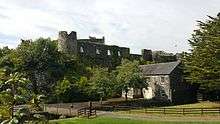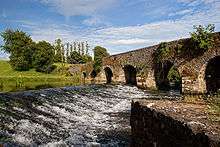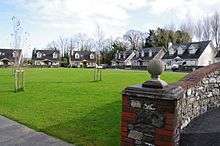Glanworth

Glanworth (Irish: Gleannúir, meaning "yew valley") is a village on the R512 regional road, 8 km northwest of the town of Fermoy in County Cork, Ireland.[1] It lies some 40 km northeast of the city of Cork, the county's administrative centre, and 210 km southwest of the capital, Dublin. The combined population of Glanworth East and Glanworth West in 2006 was 1,316, an increase of 8.6% since 2002.[2]
Glanworth has a Roman Catholic church, a school, several shops, and ten pubs. The village is commonly referred to as 'The Harbour'. This stems from the ninth century invasion of Vikings, who sailed inland as far as the monastery in Glanworth. The village was sacked and many of the women were taken back to Scandinavia as saltwives. The chilling cry of 'come on the harbour' is still often heard at sporting events.
Places of interest


Glanworth Castle
The 13th-century Glanworth Castle was built beside the River Funcheon by the Condon family, Norman settlers who arrived in the Cork area in the twelfth century. The keep and the castle wall remain. The castle is now used mainly as a public walk or a courting area.[1]
Glanworth Abbey
The Glanworth Abbey was built in the 13th century next to the castle by the Dominican order; the priory was desecrated in the 16th century. The priory's gable tracery window, now restored, was once part of the Protestant church, which is located in the Catholic graveyard.[3]
Glanworth Mill
Glanworth mill is located along the banks of the River Funcheon and sits below the imposing Norman castle. Built during the 1840 as part of a famine relief scheme it is the last remaining reverse undershot water wheel in Ireland.
Labbacallee Megalith
The Labbacallee wedge tomb is located 1.5 miles (2.4 km) from Glanworth and is the largest wedge tomb in Ireland.[4]
Neighbouring towns and villages
| Kildorrery
12 km |
Ballindangan
5 km |
Mitchelstown
17 km | |
| Castletownroche
7 km |
|
Kilworth
6 km | |
| |||
| | |||
| Mallow, County Cork
20 km |
Ballyhooly
5 km |
Fermoy
7 km |
Transport
Glanworth railway station opened on 23 March 1891, closed for passenger and goods traffic on 27 January 1947 and finally closed altogether on 1 December 1953. [5] Glanworth is still accessible by road and because of its historical status as a town it is the convergence point of many minor roads.

Sport
The town has men's and women's GAA Gaelic Athletic Association teams with a strong tradition in football, with an intermediate football team. In November 2009 they won the Cork Junior A football championship for the third time in their history, defeating Ballygarvan on a score of 8 points to 5. In 2011 and 2012 they also won the under 21A North Cork Football Championship, in 2011 defeating neighbours Fermoy by 4 points in a replay, and again beating Fermoy after extra time in 2012. It also has the 105th Scouting Troop, and a soccer club with two teams: Glanworth United and Glanworth Celtic.[6]
Film
Several scenes from the 1999 Bob Hoskins film Felicia's Journey were shot on location in Glanworth.
See also
References
- 1 2 "Glanworth's History". Archived from the original on 2007-09-29. Retrieved 2007-08-07.
- ↑ "North Cork:Changes in population 2002-2006" (PDF). Health Service Executive. 2006. Retrieved 2007-08-07.
- ↑ "National Monuments:Churchtown". Retrieved 2007-08-07.
- ↑ "The Megalithic Portal". Retrieved 2007-08-07.
- ↑ "Glanworth station" (PDF). Railscot - Irish Railways. Retrieved 2007-10-14.
- ↑ "Blackwater Valley Local Community". Retrieved 2007-08-07.
Coordinates: 52°11′7″N 8°21′25″W / 52.18528°N 8.35694°W